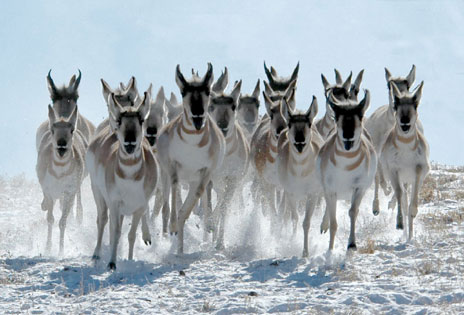


"We moved 126 pronghorn to the Northeast Region," said Dave Olsen, biologist for the Utah Division of Wildlife Resources (UDWR). "The division moved 58 new critters to the Myton Bench unit and 37 on the East Bench. The Ute Tribe also received 30 pronghorn to help enhance their herd.
"The severe drought really impacted the herds," Olsen said. "The Myton Bench herd dropped from around 1,300 [pronghorns] to less than 300, and the East Bench herd went from 900 to 200. The biologists from the Ute Tribe reported similar losses to their herds."
Olsen said the pronghorn were collected as part of a trapping operation on Parker Mountain in southern Utah. Over the last 10 years, Parker Mountain has supplied roughly 4,000 pronghorns to other areas throughout the West to enhance or reintroduce new herds. This year, biologists trapped 390 animals. Most of these animals went to the Ute Tribe, the state of Arizona, the Grand Staircase-Escalante National Monument, and to three UDWR regions - the Northeast, Southeast and Southern.
The UDWR used two traps this year. Two long, fenced wings were built to form a large funnel into a circular working area. The pronghorns were then found and herded into the trap using a helicopter. Once in the trap, biologists caught each animal and then sorted and placed them in a horse or sheep trailer for transport. Depending on their destination, some of the animals were tagged, radio-collared and/or given antibiotics or a blood test. The new recruits were then driven to their new homes and released.
Last year's snow and rains have helped the range recover, and Olsen is hopeful this enhancement will help speed the pronghorn herd recovery in northeastern Utah by increasing the number of animals and providing some new genetics.
Copyright © 2006 J & D Outdoor Communications. All rights reserved.